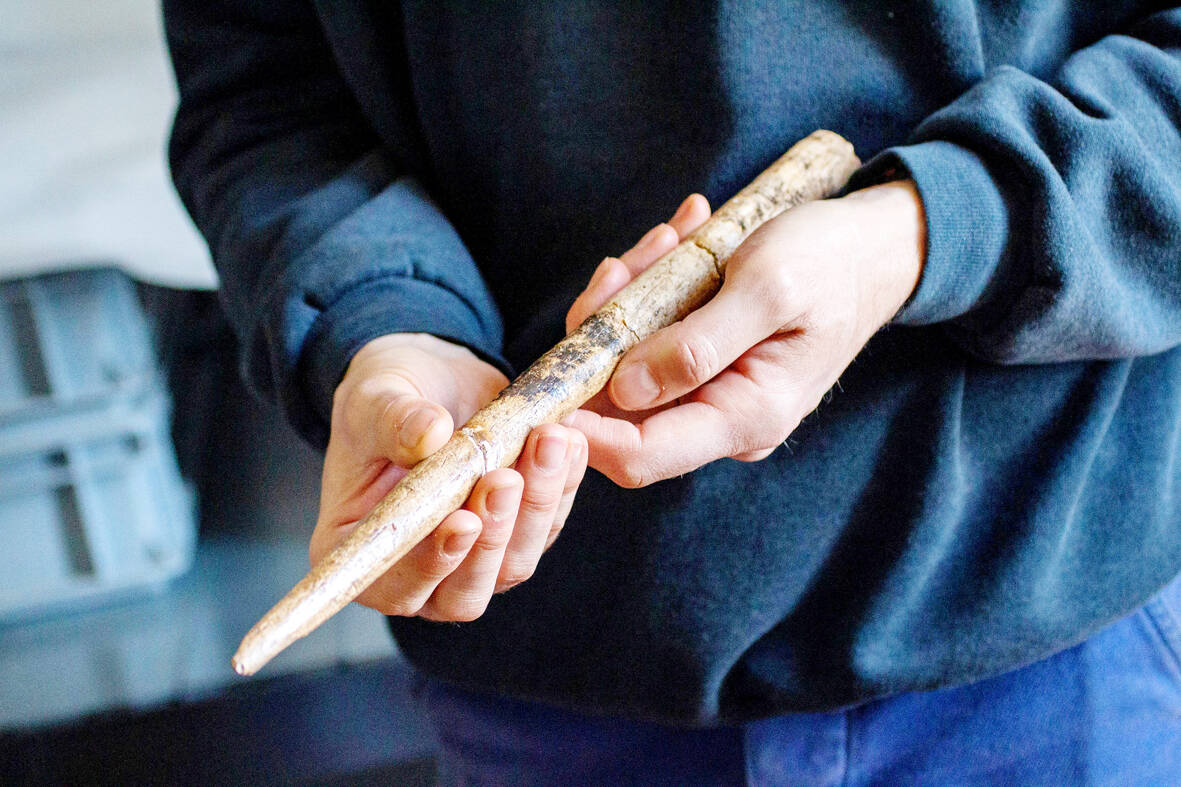Artifacts found at archeological sites in France and Spain along the Bay of Biscay shoreline show that humans have been crafting tools from whale bones since more than 20,000 years ago, illustrating anew the resourcefulness of prehistoric people.
The tools, primarily hunting implements such as projectile points, were fashioned from the bones of at least five species of large whales, the researchers said. Bones from sperm whales were the most abundant, followed by fin whales, gray whales, right or bowhead whales — two species indistinguishable with the analytical method used in the study — and blue whales.
With seafaring capabilities by humans not developing until thousands of years later, the Ice Age hunter-gatherers who made these implements would have been unable to actually hunt whales for their resources in the Bay of Biscay, a gulf of the Atlantic Ocean.

Photo: Reuters
“These whales were likely opportunistically acquired from stranded animals or drifted carcasses, rather than actively hunted,” said biomolecular archaeologist Krista McGrath of the Autonomous University of Barcelona, co-lead author of the study published in the journal Nature Communications.
“The majority of the bones were identified from offshore, deep-water species — such as sperm whale and fin whale — which would have been very difficult to hunt for these prehistoric groups. And there is no evidence from this time period that they had the level of technology that active hunting would have required, like seafaring boats,” McGrath said.
The 71 whale bone artifacts analyzed by the researchers were found at 27 cave or rock shelter sites. The two oldest ones, both from the bones of fin whales, came from the Spanish Cantabrian sites of Rascano, dating to about 20,500 years ago, and El Juyo, dating to about 19,800 years ago.
The rough age range of the artifacts was from 14,000 years old to more than 20,000 years old, but most were 16,000 to 17,500 years old.
The main raw material used to manufacture spear points at the time was antler from reindeer or red deer because it is less brittle and more pliable than land mammal bone. But whale bone offered some advantages, including its large dimensions, with some of the projectile points measuring more than 40 cm long, a size difficult to achieve using antler.
“They can be very long and thick, and were probably hafted on spear-style projectiles rather than arrows. They are usually found as fragments, many of which bear fractures related to use, and they were most likely used to hunt the main game animals of the time — reindeer and red deer, horse, bison and ibex,” said archaeologist and study co-senior author Jean-Marc Petillon of the French National Centre for Scientific Research.
Bone tools were used by members of the human evolutionary lineage dating back far before our species Homo sapiens emerged more than 300,000 years ago in Africa. The artifacts examined in this study pushed back the oldest-known use of whale bones for toolmaking by 1,000 to 2,000 years.
The objects were previously discovered at the various sites and kept in museum collections. The researchers used modern analytical techniques to determine the species from which the bones came and the age of the artifacts.
Humans living in this period of prehistory generally were inland hunters, obtaining most of their subsistence needs from the hunting of large hoofed mammals, Petillon said. The new findings enhance the understanding of their exploitation of seashore resources, Petillon added.
Previous research had shown that Ice Age people gathered seashells, hunted seabirds and fished for marine fishes as a complement to meat from terrestrial animals.
“The new findings tell us that these prehistoric groups were likely very well adapted to these coastal environments, and very likely had deep local ecological knowledge and understanding of their coastal habitats,” McGrath said.
“Whale bones would have been for more than just making tools. There is evidence for their use as fuel as well — the bones contain large amounts of oil - among other things. And the rest of the whale would also certainly have been used — teeth or baleen depending on the species, meat, skin. A single whale provides a lot of resources,” McGrath said.

The depressing numbers continue to pile up, like casualty lists after a lost battle. This week, after the government announced the 19th straight month of population decline, the Ministry of the Interior said that Taiwan is expected to lose 6.67 million workers in two waves of retirement over the next 15 years. According to the Ministry of Labor (MOL), Taiwan has a workforce of 11.6 million (as of July). The over-15 population was 20.244 million last year. EARLY RETIREMENT Early retirement is going to make these waves a tsunami. According to the Directorate General of Budget Accounting and Statistics (DGBAS), the

Last week the story of the giant illegal crater dug in Kaohsiung’s Meinong District (美濃) emerged into the public consciousness. The site was used for sand and gravel extraction, and then filled with construction waste. Locals referred to it sardonically as the “Meinong Grand Canyon,” according to media reports, because it was 2 hectares in length and 10 meters deep. The land involved included both state-owned and local farm land. Local media said that the site had generated NT$300 million in profits, against fines of a few million and the loss of some excavators. OFFICIAL CORRUPTION? The site had been seized

Next week, candidates will officially register to run for chair of the Chinese Nationalist Party (KMT). By the end of Friday, we will know who has registered for the Oct. 18 election. The number of declared candidates has been fluctuating daily. Some candidates registering may be disqualified, so the final list may be in flux for weeks. The list of likely candidates ranges from deep blue to deeper blue to deepest blue, bordering on red (pro-Chinese Communist Party, CCP). Unless current Chairman Eric Chu (朱立倫) can be convinced to run for re-election, the party looks likely to shift towards more hardline

Sept. 15 to Sept. 21 A Bhutanese princess caught at Taoyuan Airport with 22 rhino horns — worth about NT$31 million today — might have been just another curious front-page story. But the Sept. 17, 1993 incident came at a sensitive moment. Taiwan, dubbed “Die-wan” by the British conservationist group Environmental Investigation Agency (EIA), was under international fire for being a major hub for rhino horn. Just 10 days earlier, US secretary of the interior Bruce Babbitt had recommended sanctions against Taiwan for its “failure to end its participation in rhinoceros horn trade.” Even though Taiwan had restricted imports since 1985 and enacted